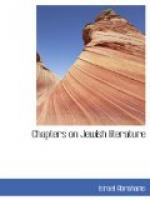—— Studies in Judaism (Jewish
Publication Society of America,
1896), pp. 155, 182, 213, 233 [189, 222,
259, 283].
B. Spiers.—School System of the Talmud
(London, 1898)
(with appendix on Baba Kama); the Threefold
Cord (1893)
on Sanhedrin, Baba Metsia, and
Baba Bathra.
M. Jastrow.—History and Future of the
Text of the Talmud
(Publications of the Gratz College,
Philadelphia, 1897, Vol. I).
P.B. Benny.—Criminal Code of the
Jews according to the Talmud
(London, 1880).
S. Mendelsohn.—The Criminal Jurisprudence
of the Ancient Hebrews
(Baltimore, 1891).
D. Castelli.—Future Life in Rabbinical
Literature, J.Q.R.,
I, p. 314.
M. Guedemann.—Spirit and Letter in Judaism
and Christianity,
ibid., IV, p. 345.
I. Harris.—Rise and Development of the
Massorah,
ibid., I, pp. 128, etc.
H. Polano.—The Talmud (Philadelphia, 1876).
I. Myers.—Gems from the Talmud (London, 1894).
D.W. Amram.—The Jewish Law of Divorce
according to Bible and
Talmud (Philadelphia, 1896).
CHAPTER IV
THE MIDRASH AND ITS POETRY
Mechilta, Sifra, Sifre, Pesikta,
Tanchuma, Midrash
Rabbah, Yalkut.—Proverbs.—Parables.—Fables.
In its earliest forms identical with the Halachah, or the practical and legal aspects of the Mishnah and the Talmud, the Midrash, in its fuller development, became an independent branch of Rabbinical literature. Like the Talmud, the Midrash is of a composite nature, and under the one name the accumulations of ages are included. Some of its contents are earlier than the completion of the Bible, others were collected and even created as recently as the tenth or the eleventh century of the current era.
Midrash ("Study,” “Inquiry”) was in the first instance an Explanation of the Scriptures. This explanation is often the clear, natural exposition of the text, and it enforces rules of conduct both ethical and ritual. The historical and moral traditions which clustered round the incidents and characters of the Bible soon received a more vivid setting. The poetical sense of the Rabbis expressed itself in a vast and beautiful array of legendary additions to the Bible, but the additions are always devised with a moral purpose, to give point to a preacher’s homily or to inspire the imagination of the audience with nobler fancies. Besides being expository, the Midrash is, therefore, didactic and poetical, the moral being conveyed in the guise of a narrative, amplifying and developing the contents of Scripture. The Midrash gives the results of that deep searching of the Scriptures which became second nature with the Jews, and it also represents the changes and expansions of ethical and theological ideals as applied to a changing and growing life.




